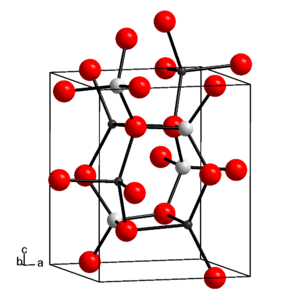Lithium aluminate facts for kids
Lithium aluminate is a special type of chemical compound that does not come from living things. Its chemical formula is LiAlO2. You might also hear it called lithium aluminium oxide. It is a compound made from lithium and aluminium oxide, which is why it's called an aluminate of lithium.
Contents
What is Lithium Aluminate?
Lithium aluminate is usually a white, solid powder. It's known for being very stable, especially when it gets hot. This means it doesn't easily break down or change when heated to high temperatures. It's a type of ceramic material, which are materials that are often hard, strong, and can handle heat well.
What Does It Look Like?
Lithium aluminate typically appears as a fine, white powder. It doesn't have a strong smell. Because it's a ceramic, it's very hard and doesn't dissolve easily in water. It can exist in different forms, called "polymorphs," depending on how it's made. The most common forms are alpha (α-LiAlO2) and gamma (γ-LiAlO2).
How Is It Used?
Lithium aluminate has several important uses, especially in areas where materials need to be strong and resistant to heat.
Fuel Cells
One of its main uses is in fuel cells. Fuel cells are devices that turn chemical energy into electrical energy, much like batteries, but they can keep producing electricity as long as they have fuel. Lithium aluminate is used as a material that helps conduct ions (tiny charged particles) in some types of fuel cells, like molten carbonate fuel cells (MCFCs). It acts as a support structure for the electrolyte, which is the part that allows the ions to move.
Nuclear Reactors
Lithium aluminate can also be used in nuclear reactors. In these reactors, it can be used to produce tritium, which is a special type of hydrogen. This is important for future energy technologies, especially for fusion reactors that aim to create energy by combining atoms.
Other Uses
- Ceramics: Because it can handle high temperatures, lithium aluminate is used in making special ceramics. These ceramics might be used in things like oven linings or parts that need to withstand extreme heat.
- Catalysts: Sometimes, it's used as a support material for catalysts. Catalysts are substances that speed up chemical reactions without being used up themselves.
- Glass and Glazes: It can also be added to glass and glazes to change their properties, like making them stronger or more resistant to heat.
Making Lithium Aluminate
Lithium aluminate is usually made by heating up lithium oxide or lithium carbonate with aluminium oxide at very high temperatures. This process causes the different chemicals to combine and form the new compound. Scientists and engineers carefully control the temperature and other conditions to make sure they get the right type of lithium aluminate for its intended use.


